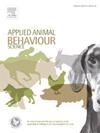Evaluation of welfare indicators for companion parrots: a Delphi consultation survey
IF 2.2
2区 农林科学
Q1 AGRICULTURE, DAIRY & ANIMAL SCIENCE
引用次数: 0
Abstract
Parrots can experience several welfare challenges when kept as companions. Despite their popularity no science-based guidelines are available to assess parrot welfare. The aim of this Delphi study was to establish consensus on welfare indicators that could be meaningful and practical for owners to monitor parrot welfare. One hundred and twenty-two potential welfare indicators (behaviours, body measurements, husbandry and management conditions) were sourced from a systematic literature review and by consulting an avian medicine specialist. They were presented to participants with expertise on parrots in two rounds of online survey. We identified 73 welfare indicators that could be used by owners to monitor the welfare of all/most parrot species. Abnormal behaviours and management conditions that allow parrots to express their natural behaviours were ranked among the most important indicators. Participants concurred with scientific evidence about the impact of diet, species susceptibility to develop behavioural problems, early life, and pre-acquisition experiences on parrot welfare. When prompted about the suitability of species as companions, participants indicated seven small-sized parrot species as most suitable to be kept as a companion, while cockatoos, critically endangered, and highly trafficked species were evaluated as those that should not be kept as companions. These findings could be useful to monitor and improve parrot welfare.
同伴鹦鹉福利指标评价:德尔菲咨询调查
当鹦鹉作为同伴被饲养时,它们会经历一些福利方面的挑战。尽管它们很受欢迎,但没有科学的指导方针来评估鹦鹉的福利。本德尔菲研究的目的是建立对福利指标的共识,这些指标对主人监测鹦鹉的福利有意义和实用性。122项潜在福利指标(行为、身体测量、饲养和管理条件)来自系统的文献综述并咨询了禽类医学专家。在两轮在线调查中,他们被介绍给具有鹦鹉专业知识的参与者。我们确定了73个福利指标,业主可以使用这些指标来监测所有/大多数鹦鹉物种的福利。允许鹦鹉表达其自然行为的异常行为和管理条件被列为最重要的指标。参与者同意有关饮食、物种对发展行为问题的易感性、早期生活和习得前经历对鹦鹉福利的影响的科学证据。当被提示物种是否适合作为伴侣时,参与者指出7种小型鹦鹉是最适合作为伴侣的,而凤头鹦鹉,极度濒危和高度贩运的物种被评估为不应该作为伴侣。这些发现可能对监测和改善鹦鹉的福利有帮助。
本文章由计算机程序翻译,如有差异,请以英文原文为准。
求助全文
约1分钟内获得全文
求助全文
来源期刊

Applied Animal Behaviour Science
农林科学-行为科学
CiteScore
4.40
自引率
21.70%
发文量
191
审稿时长
18.1 weeks
期刊介绍:
This journal publishes relevant information on the behaviour of domesticated and utilized animals.
Topics covered include:
-Behaviour of farm, zoo and laboratory animals in relation to animal management and welfare
-Behaviour of companion animals in relation to behavioural problems, for example, in relation to the training of dogs for different purposes, in relation to behavioural problems
-Studies of the behaviour of wild animals when these studies are relevant from an applied perspective, for example in relation to wildlife management, pest management or nature conservation
-Methodological studies within relevant fields
The principal subjects are farm, companion and laboratory animals, including, of course, poultry. The journal also deals with the following animal subjects:
-Those involved in any farming system, e.g. deer, rabbits and fur-bearing animals
-Those in ANY form of confinement, e.g. zoos, safari parks and other forms of display
-Feral animals, and any animal species which impinge on farming operations, e.g. as causes of loss or damage
-Species used for hunting, recreation etc. may also be considered as acceptable subjects in some instances
-Laboratory animals, if the material relates to their behavioural requirements
 求助内容:
求助内容: 应助结果提醒方式:
应助结果提醒方式:


